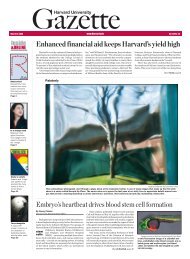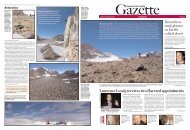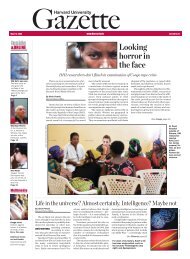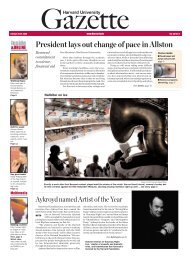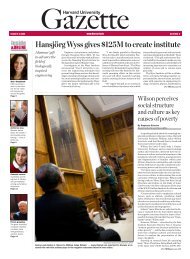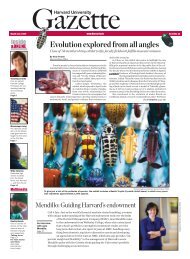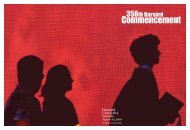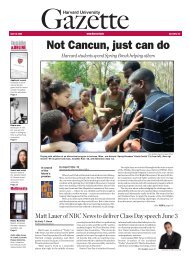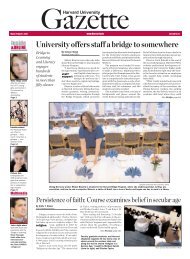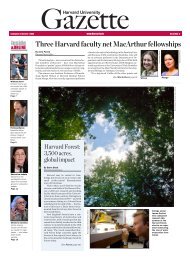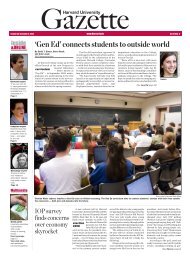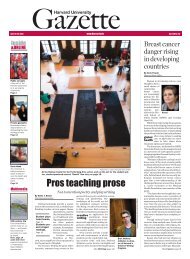Harvard University Gazette December 4-10, 2008 - Harvard News ...
Harvard University Gazette December 4-10, 2008 - Harvard News ...
Harvard University Gazette December 4-10, 2008 - Harvard News ...
You also want an ePaper? Increase the reach of your titles
YUMPU automatically turns print PDFs into web optimized ePapers that Google loves.
<strong>December</strong> 4-<strong>10</strong>, <strong>2008</strong> <strong>Harvard</strong> <strong>University</strong> <strong>Gazette</strong>/ 13<br />
Seminar focuses on human rights<br />
Provides forum for discussion<br />
of research, methods, practices<br />
By Emily T. Simon<br />
FAS Communications<br />
In this drawing, 12-year-old Basma of Darfur depicts<br />
the invasion of her village by the Islamic militia<br />
group Janjaweed. Terrorists on horseback are reinforced<br />
by helicopter gunships.<br />
Images of terror through<br />
the eyes of children<br />
By Corydon Ireland<br />
<strong>Harvard</strong> <strong>News</strong> Office<br />
Basma was 8 when Janjaweed fighters on horseback<br />
swept into her village in the Darfur region of Sudan.<br />
Above them, helicopter gunships joined in the attack.<br />
Last year, from the safety of a refugee camp in neighboring<br />
Chad, Basma rendered the incident in a drawing.<br />
She was prompted by a researcher from a United Kingdom-based<br />
human rights group called Waging Peace.<br />
Her vividly detailed sketch, in colored pencil, is among<br />
500 collected by researcher Anna Schmitt from children<br />
ages 6 to 18. Waging Peace turned them over to the International<br />
Criminal Court, which last fall accepted them<br />
as contextual evidence of murder and genocide.<br />
Forty-six of the drawings are on display through Dec.<br />
12 in the Collins Family Rotunda at the <strong>Harvard</strong> Kennedy<br />
School’s (HKS) Taubman Building. The exhibit is part of<br />
a <strong>University</strong>-wide commemoration of the Universal Declaration<br />
of Human Rights, 30 articles thought to embody<br />
humankind’s fundamental rights.<br />
The United Nations document — both widely inspiring<br />
and widely ignored — turns 60 years old on Dec. <strong>10</strong>.<br />
Human rights Basma knows at least how easily they<br />
can be violated. On the right side of her drawing, the size<br />
of a letter, a line of men fire assault rifles. On the left are<br />
fleeing figures, including an old woman stooped over a<br />
cane. Under dotted lines of bullets, bodies lay sprawled.<br />
In the drawing’s center are intimations of what life<br />
was like before the attack: a gaily colored hut, a bird<br />
perched on a flowering tree, a pecking rooster. But<br />
throughout the piece, each object and figure — hut, tree,<br />
rooster, fallen body, tassel-capped fighter — is identified<br />
by a feathery scrawl in Arabic. Though briefly, Basma provides<br />
the testimony of words as well as pictures.<br />
Since 2003 in Darfur, the poorest of Sudan’s five regions,<br />
light-skinned Janjaweed Arab militias — supported<br />
by the government of Sudan — have been killing black<br />
African villagers and refugees by the hundreds of thousands.<br />
Drawing No. 1 in the exhibit, done by an unnamed boy<br />
of 13, clearly shows the ethnic character of the conflict.<br />
A light-brown fighter, his rifle on one hip, calmly fires at<br />
long-robed men the color of charcoal. Another fighter<br />
leads two dark-faced children away, tied at the neck. Slavery<br />
— and child soldiers — are part of the Darfur story too.<br />
In response, the United Nations has passed five resolutions<br />
since 2004, including ones to halt the flow of arms<br />
(See Darfur, next page)<br />
60<br />
<strong>Harvard</strong><br />
celebrates<br />
The Universal<br />
Declaration of<br />
Human<br />
Rights<br />
These are part<br />
of a series of<br />
events and academic<br />
innovations<br />
in a yearlong<br />
<strong>Harvard</strong> celebration<br />
of the<br />
60th anniversary<br />
of the Universal<br />
Declaration of<br />
Human Rights.<br />
Taking part in the noncredit seminar<br />
are Dominique Gracia ’09 (above, from<br />
left), Nadira Lalji ’09, and Kelsey<br />
Quigley ’08-09. Another member of the<br />
class is Jenne Ayers ’<strong>10</strong> (below).<br />
The undergraduates who gather around the<br />
seminar table at 61 Kirkland St. have a lot on their<br />
minds. Not just final papers, athletic matches, and<br />
music performances, but a range of issues that run<br />
far beyond the daily stresses of college: Refugee<br />
resettlement. Human trafficking. Child soldiers.<br />
These human rights issues — along with many<br />
others — are the challenges that have inspired this<br />
group of passionate students to add another<br />
course to their jam-packed schedules.<br />
This fall marks the inaugural semester of the<br />
Human Rights Scholars Seminar, a biweekly, noncredit<br />
class for juniors and seniors with a dedicated<br />
interest in human rights-related research.<br />
The yearlong course provides a forum for the discussion<br />
of human rights scholarship, research<br />
methods, and practices.<br />
“The seminar aims to introduce students to a<br />
range of methodologies relevant to human rights<br />
research, to put them in touch with ongoing<br />
human rights research by faculty and leading experts<br />
in the field, and to give them an opportunity<br />
to discuss this material in a small, interdisciplinary<br />
group context,” said Jacqueline Bhabha,<br />
director of the <strong>Harvard</strong> <strong>University</strong> Committee on<br />
Human Rights Studies (UCHRS).<br />
Conceived and developed by UCHRS committee<br />
members, the course is one of many <strong>Harvard</strong><br />
initiatives to celebrate the 60th anniversary of the<br />
Universal Declaration of Human Rights. The seminar<br />
is led by Cosette Creamer, a Ph.D. candidate<br />
in the Department of Government and a J.D. candidate<br />
at <strong>Harvard</strong> Law School.<br />
“For me … the most rewarding aspect of teaching<br />
this seminar is what I hope is also the most rewarding<br />
aspect for the students: a broadened perspective<br />
on how to think about conducting human<br />
rights research,” Creamer said.<br />
Entry to the seminar was determined by a competitive<br />
application process in September. The<br />
group numbers 24 students from a variety of concentrations,<br />
including government, history and<br />
literature, social studies, and biology.<br />
Sara O’Rourke ’09, a social studies concentrator,<br />
applied to the seminar to “learn about the<br />
dominant discourse and literature on human<br />
rights, and to meet other students whose work has<br />
to do with human rights.” She is interested in<br />
women’s rights, current issues facing Islam, and<br />
the relationship between international and domestic<br />
law.<br />
On alternate Thursday evenings, Creamer and<br />
(See Class, next page)<br />
Clarence Dillon<br />
Professor of International<br />
Affairs<br />
Beth Simmons<br />
(at end of<br />
table) talks<br />
about human<br />
rights compliance.<br />
Photos<br />
Kris Snibbe/<br />
<strong>Harvard</strong> <strong>News</strong> Office



